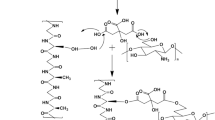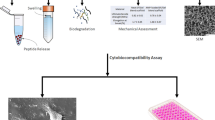Abstract
Gentamicin sulfate (GS)-loaded silk fibroin (SF)/gelatin (Gel) scaffolds were prepared by the freeze-drying method. The effect of blending ratios of SF and Gel (i.e., 0/100, 30/70, 50/50, 70/30, and 100/0) in the scaffolds on the morphology, pore size, compressive modulus, water swelling, weight loss, and release profiles was investigated. The pore sizes of the neat and the GS-loaded SF/Gel blend scaffolds were 60–138 μm. Increasing SF content and the addition of GS in the scaffolds caused the compressive modulus of the scaffolds to decrease. Moreover, the addition of GS caused the water swelling and weight loss behaviors of these scaffolds to increase. The cumulative released amount of GS from the GS-loaded SF/Gel blend scaffolds decreased with an increase of SF content in the scaffolds. All scaffolds showed high activity against the growth of Staphylococcus aureus, Staphylococcus epidermidis, Micrococcus luteus, Bacillus cereus, and Pseudomonas aeruginosa,. Finally, all the GS-loaded SF/Gel blend scaffolds were proven non-toxic to NHDF cells except for the GS-loaded SF/Gel blend scaffolds at blending ratio 100/0. From these results, these scaffolds had the potential for use as wound dressing materials.





Similar content being viewed by others
References
Clark RAF, Ghosh K, Tonnesen MG (2007) Tissue engineering for cutaneous wounds. J Invest Dermatol 127:1018–1029. doi:10.1038/sj.jid.5700715
Balasubramani M, Kumar TR, Babu M (2001) Skin substitutes: a review. Burns 27:534–544. doi:10.1016/S0305-4179(01)00018-3
Singer AJ, Clark RAF (1999) Cutaneous wound healing. N Engl J Med 341:738–746. doi:10.1056/NEJM199909023411006
Elsner JJ, Zilberman M (2010) Novel antibiotic-eluting wound dressings: an in vitro study and engineering aspects in the dressing’s design. J Tissue Viability 19:54–66. doi:10.1016/j.jtv.2009.11.001
Stashak TS, Farstvedt E, Othic A (2004) Update on wound dressings: indications and best use. Clin Tech Equine Pract 3:148–163. doi:10.1053/j.ctep.2004.08.006
Zhong SP, Zhang YZ, Lim CT (2010) Tissue scaffolds for skin wound healing and dermal reconstruction. Wiley Interdiscip Rev Nanomed Nanobiotechnol 2:510–525. doi:10.1002/wnan.100
Dhandayuthapani B, Yoshida Y, Maekawa T, Kumar DS (2011) Polymeric scaffolds in tissue engineering application: a review. Int J Polym Sci 2011:1987–9422. doi:10.1155/2011/290602
Hou Q, Grijpma DW, Feijen J (2003) Preparation of interconnected highly porous polymeric structures by a replication and freeze-drying process. J Biomed Mater Res B 67:732–740. doi:10.1002/jbm.b.10066
Lu T, Li Y, Chen T (2013) Techniques for fabrication and construction of three-dimensional scaffolds for tissue engineering. Int J nanomedicine 8:337–350. doi:10.2147/IJN.S38635
Chen G, Ushida T, Tateishi T (2002) Scaffold design for tissue engineering. Macromol Biosci 2:67–77. doi:10.1002/1616-5195(20020201)2:2<67:AID-MABI67>3.0.CO;2-F
Hariraksapitak P, Supaphol P (2010) Preparation and properties of α-chitin-whisker-reinforced hyaluronan–gelatin nanocomposite scaffolds. J Appl Polym Sci 117:3406–3418. doi:10.1002/app.32095
Shahverdi S, Hajimiri M, Esfandiari MA, Larijani B, Atyabi F, Rajabiani A, Dehpour AR, Gharehaghaji AA, Dinarvand R (2014) Fabrication and structure analysis of poly(lactide-co-glycolic acid)/silk fibroin hybrid scaffold for wound dressing applications. Int J Pharm 473:345–355. doi:10.1016/j.ijpharm.2014.07.021
Singaravelu S, Ramanathan G, Raja MD, Nagiah N, Padmapriya P, Kaveri K, Sivagnanam UT (2016) Biomimetic interconnected porous keratin–fibrin–gelatin 3D sponge for tissue engineering application. Int J of Biol Macromolec 86:810–819. doi:10.1016/j.ijbiomac.2016.02.021
Mahmoud AA, Salama AH (2016) Norfloxacin-loaded collagen/chitosan scaffolds for skin reconstruction: preparation, evaluation and in vivo wound healing assessment. Eur J Pharm Sci 83:155–165. doi:10.1016/j.ejps.2015.12.026
Carvalho IC, Mansur HS (2017) Engineered 3D-scaffolds of photocrosslinked chitosan-gelatin hydrogel hybrids for chronic wound dressings and regeneration. Mater Sci Eng C 78:690–705. doi:10.1016/j.msec.2017.04.126
Han F, Dong Y, Su Z, Yin R, Song A, Li S (2014) Preparation, characteristics and assessment of a novel gelatin–chitosan sponge scaffold as skin tissue engineering material. Int J Pharm 476:124–133. doi:10.1016/j.ijpharm.2014.09.036
Shi L, Yang N, Zhang H, Chen L, Tao L, Wei Y, Liu H, Luo Y (2015) A novel poly(γ-glutamic acid)/silk-sericin hydrogel for wound dressing: synthesis, characterization and biological evaluation. Mater Sci Eng C 48:533–540. doi:10.1016/j.msec.2014.12.047
Gómez-Guillén MC, Giménez B, López-Caballero ME, Montero MP (2011) Functional and bioactive properties of collagen and gelatin from alternative sources: a review. Food Hydrocoll 25:1813–1827. doi:10.1016/j.foodhyd.2011.02.007
Zhang Q, Wang Q, Lv S, Lu J, Jiang S, Regenstein JM, Lin L (2016) Comparison of collagen and gelatin extracted from the skins of Nile tilapia (Oreochromis niloticus) and channel catfish (lctalurus punctatus). Food Biosci 13:41–48. doi:10.1016/j.fbio.2015.12.005
Aflaro AT, BalbinotE Weber CI, Tonial IV, Machado-Lunkes A (2015) Fish gelatin: characteristics, functional properties, applications and future potentials. Food Eng Rev 7:33–44. doi:10.1007/s12393-014-9096-5
Rattanaruengsrikul V, Pimpha N, Supaphol P (2009) Development of gelatin hydrogel pads as antibacterial wound dressings. Macromol Biosci 9:1004–1015. doi:10.1002/mabi.200900131
Dille M, Hattrem MN, Draget KI (2017) Soft, chewable gelatin-based pharmaceutical oral formulations: a technical approach. Pharm Dev Technol 2:1–8. doi:10.1080/10837450.2017.1332642
Han M-E, Kang BJ, Kim S-H, Kim HD, Hwang NS (2017) Gelatin-based extracellular matrix cryogels for cartilage tissue engineering. J Ind Eng Chem 45:421–429. doi:10.1016/j.jiec.2016.10.011
Altman GH, Diaz F, Jakuba C, Calabro T, Horan RL, Chen J, Lu H, Richmond J, Kaplan DL (2003) Silk-based biomaterials. Biomaterials 24:401–416. doi:10.1016/S0142-9612(02)00353-8
Hardy JG, Römer LM, Scheibel TR (2008) Polymeric materials based on silk proteins. Polymer 49:4309–4327. doi:10.1016/j.polymer.2008.08.006
Aviv M, Berdicevsky I, Zilberman M (2007) Gentamicin-loaed bioresorbable films for prevention of bacterial infections associated with orthopedic implants. J Biomed Mater Res A 83:10–19. doi:10.1002/jbm.a.31184
Jacobsen F, Fisahn C, Sorkin M, Thiele I, Hirsch T, Stricker I, Klaassen T, Roemer A, Fugmann B, Steinstraesser L (2011) Efficacy of topically delivered moxifloxacin against wound infection by Pseudomonas aeruginosa and methicillin-resistant Staphylococcus aureus. Antimicrob Agents Chemother 55:2325–2334. doi:10.1128/AAC.01071-10
Jetbumpenkul P, Amornsudthiwat P, Kanokpanont S, Damrongsakkul S (2012) Balanced electrosatatic blending approach—an alternative to chemical crosslinking of Thai silk fibroin/gelatin scaffold. Int J Biol Macromolec 50:7–13. doi:10.1016/j.ijbiomac.2011.08.028
Farris S, Song J, Huang Q (2010) Alternative reaction mechanism for the cross-linking of gelatin with glutaraldehyde. J Agric Food Chem 58:996–1003. doi:10.1021/jf9031603
Frutos P, Torrado S, Perez-Lorenzo ME, Frutos G (2000) A validated quantitative colorimetric assay for gentamicin. J Pharm Biomed Anal 21:1149–1159. doi:10.1016/S0731-7085(99)00192-2
Yannas IV, Lee E, Orgill DP, Skrabut EM, Murphy GF (1989) Synthesis and characterization of a model extracellular matrix that induces partial regeneration of adult mammalian skin. Proc Natl Acad Sci USA 86:933–937
Zhou Q, Gong Y, Gao C (2005) Microstructure and mechanical properties of poly(L-lactide) scaffolds fabricated by gelatin particle leaching method. J Appl Polym Sci 98:1373–1379. doi:10.1002/app.22289
Liu W, Chang J (2009) In vitro evaluation of gentamicin release from bioactive tricalcium silicate bone cement. Mater Sci Eng C 29:2486–2492. doi:10.1016/j.msec.2009.07.015
Acknowledgements
The authors would like to acknowledge the financial support from Mae Fah Luang University, Professor Pitt Supaphol for being a mentor and Nano Characterization Laboratory: NCL, NANOTEC for indirect cytotoxicity evaluation. In addition, K. Kiti gratefully acknowledges the Royal Golden Jubilee Ph.D. scholarship (PHD/0043/2559), Thailand Research Fund (TRF).
Author information
Authors and Affiliations
Corresponding author
Rights and permissions
About this article
Cite this article
Kiti, K., Kudithalert, P., Waratrujiwong, T. et al. The potential use of gentamicin sulfate-loaded silk fibroin/gelatin blend scaffolds for wound dressing materials. Polym. Bull. 75, 2543–2558 (2018). https://doi.org/10.1007/s00289-017-2170-4
Received:
Revised:
Accepted:
Published:
Issue Date:
DOI: https://doi.org/10.1007/s00289-017-2170-4




